WoW Archivist: Patch 2.4 -- Fury of the Sunwell
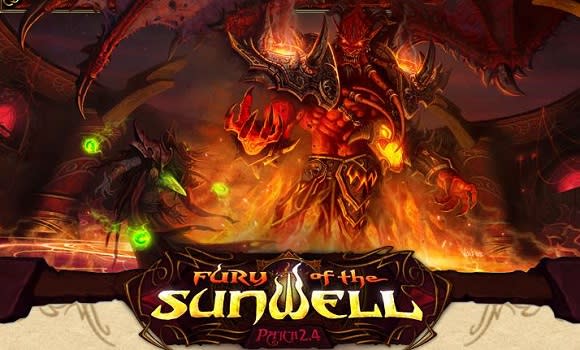
WoW Archivist explores the secrets of World of Warcraft's past. What did the game look like years ago? Who is etched into WoW's history? What secrets does the game still hold?
On March 4, 2008, Gary Gygax, the creator of Dungeons & Dungeons, passed away. A few weeks later, Blizzard dedicated the final and meatiest patch of the Burning Crusade expansion to Gary's memory.
Unlike the raid- and druid-centric patch 2.1, the big nothing of 2.2, or the old world revamp (and another raid) of patch 2.3, Fury of the Sunwell had boatloads of new endgame content for everyone. Blizzard also provided a trailer for the patch that showed the history of the Sunwell and revealed Kael'thas' diabolical plan.
Redefining realm-wide events
Kael'thas had to be stopped. The naaru convinced the Scryers and the Aldor to work together, forming a new faction to retake the Sunwell at the Isle of Que'Danas. The Shattered Sun Offensive represented a massive evolution of the realm-wide event concept after the very popular Gates of Ahn'qiraj event ushered in the idea. Daily quests, introduced in The Burning Crusade, were the key.
The Gates event required players to gather and turn in crafting supplies. Though you certainly felt like a contributor by forking over dozens of stacks of cloth, the gameplay aspect was lacking. Only one guild per realm could participate in the complete quest line.
On Quel'Danas, everyone could experience the story as it played out. Instead of turning in items, your realm earned credit toward the next phase of the event when players completed dailies. Rather than a one-time event, the phases changed and unlocked different parts of the island to show the Offensive's progress. Eventually the united Scryers and Aldor built a town, complete with a blacksmith for repairs, alchemy lab, portal, and statues to honor the fallen. Each new phase also brought new dailies and new rewards that could be purchased with gold and "badges" (TBC's equivalent of valor points). All of these changes were permanent, so you didn't have to log in on a specific day in order to enjoy them.
Though it is somewhat primitive compared to what Blizzard achieved with the Molten Front and Isle of Thunder events, the Shattered Sun Offensive provided the prototype for these later efforts. It redefined what a world event could be. Though dailies are something of a dirty word these days, players of the era looked at the Offensive as one of Blizzard's most successful endeavors. Virtually everything about it was a step up over the Gates of Ahn'qiraj. All it lacked in comparison was the epic scope of the invasion of Kalimdor.
Of course, the isle was more than just a daily quest hub. Along with it came a new dungeon and a new raid.
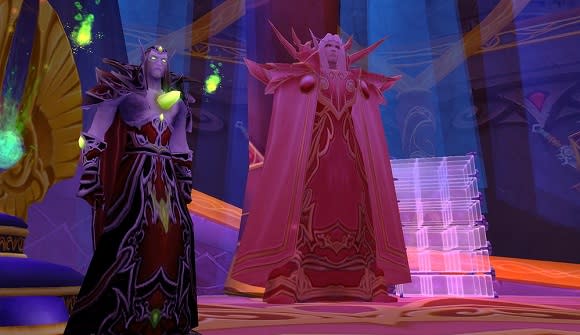
Merely a setback
If you ever wondered where that meme came from, the answer lies in Magister's Terrace, patch 2.4's new 5-player dungeon. Players had killed Kael'thas, the end boss of Tempest Keep, at the beginning of the expansion. Yet he had returned, less powerful but still very much alive and causing trouble once again. A shrunken, frail-looking Kael'thas told players that "Tempest Keep was merely a setback."
Magister's Terrace was the first dungeon to feature a cutscene. It triggered when you clicked on a scrying orb, so unlike many cutscenes of today it didn't have to be canceled every time you ran the dungeon. The cutscene showed you a fly-through of Sunwell Plateau, including the Sunwell itself, where the summoning of Kil'jaeden had begun.
Both normal and Heroic modes were challenging. TBC-era dungeons tended to be difficult. With just four bosses, the Terrace managed to be the toughest of the bunch. Priestess Delrissa in particular gave groups fits and initiated many a mid-run ragequit. The encounter had no aggro table, so players had to survive by using personal cooldowns and crowd control, much like in PvP. Blizzard had done this once before in the Dungeon Set 2 quest line, and later the infamous Faction Champions encounter in Wrath's Trial of the Crusader followed up on the idea.
The once-beaten Kael'thas was no pushover, either. Your tank would get one-shot by Pyroblast if your DPS couldn't burn through Kael'thas' shield in time to interrupt it. Phoenix adds that died in a huge burst of flame had to be kited and killed -- and they respawned if you didn't destroy the egg they left behind. At 50% health, Kael'thas cast Gravity Lapse, which gave everyone the ability to fly but dealt roomwide damage. He also summoned Arcane Spheres that would dart around the room, dealing massive damage if you flew into one. For their trouble, players were rewarded with epic drops on both difficulties.
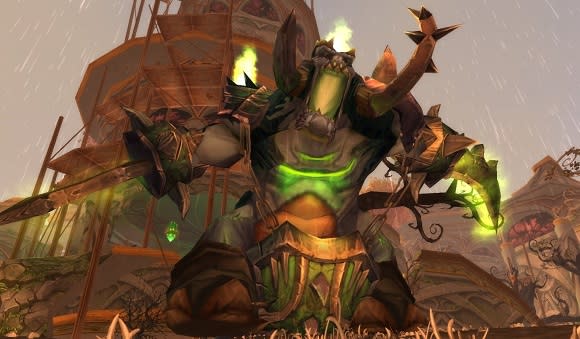
To crush the legion
Only three bosses of Sunwell Plateau could be faced when the raid first became available. Because the trash dropped epics and epic recipes (including new engineering goggles) far beyond what was available to the average player, pick-up groups formed just to farm the first pulls.
The remaining three bosses were locked behind three gates that opened every few weeks. The "gating" of bosses was a controversial topic -- especially since the gates opened on maintenance days, setting the EU one day behind the US. The first three bosses were tuned tightly, but were similar to other Tier 6 fights. The final three were on another level of difficulty and none but the hardest of the hardcore could defeat them.
M'uru was not a difficult encounter from a mechanics standpoint, but the requirements of healing and DPS were utterly brutal, and tanks really had to be on the ball to control adds and survive. The original version was an encounter that pushed every single player in the raid to their absolute limit. M'uru was so difficult that he was nerfed in two straight patches, and several WoW Insider writers consider him the hardest WoW boss of all time.
To overcome the challenge of fights like M'uru, raids stacked their rosters. They added as many shamans as possible for their Chain Lightning, Chain Heal, and Bloodlust abilities (Bloodlust was only party-wide and didn't give a sated debuff). Raid leaders also asked everyone to switch to leatherworking for the Drums of Battle mini-Lust that only leatherworkers could provide.
In large part, the raid stacking in Sunwell Plateau was the genesis of Blizzard's "bring the player, not the class" policy. This philosophy triggered the spread of buffs and utilities among classes in later expansions.
Another issue was the Sunwell Radiance buff/debuff that all enemies in the raid possessed. Tanks had so much avoidance at that point in the expansion that Blizzard had no choice but to nerf their avoidance severely while in the raid. However, Blizzard didn't tell anyone about it at first, and the ability was invisible. Tanks and healers could tell something was off, but not what. Radiance caused a stir when players found out what was really happening. In the end, the change was necessary to avoid designing bosses that hit hard enough to two-shot a tank.
Defeating Kil'jaeden triggered a scripted event, in which Prophet Velen and Lady Liadrin reignite the Sunwell using the heart of the corrupted naaru, M'uru.
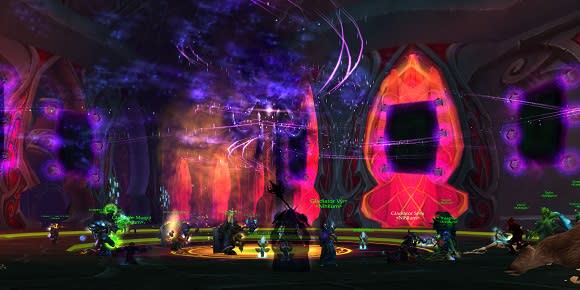
The end of attunements
Along with the new raid came several changes to the previous ones. The dreaded attunements for Karazhan, Hyjal, and the Black Temple were removed. Anyone who completed the latter two prior to the patch received the Hand of A'dal title. In addition, you didn't have to clear all the prior bosses of Tempest Keep or Serpentshrine Cavern in order to face Kael'thas or Vashj.
All of this was a huge deal at the time. Raiders were pretty sick of getting every new member attuned to raids, and in fact many raiding guilds simply wouldn't consider your application if you weren't attuned. It made joining a raiding guild very difficult in late TBC if you hadn't been raiding since the start of the expansion.
For 25-man raids, Blizzard also increased the amount of gold and the number of tier tokens that dropped from bosses (from one to two). World boss drops were changed from bind on pickup to bind on equip so they could be sold on the auction house or given to guildmates.
All in all, the changes made it much easier for players to gear up for Sunwell, although it was still exponentially harder for a player to catch up in The Burning Crusade than in every later expansion.
Shrimpin' ain't easy
The first fishing dailies arrived in patch 2.4. (And yes, one of them was actually called "Shrimpin' Ain't Easy.") Old Man Barlo offered the quests at a lake near Shattrath. While most quests required you to fish in various Outland locales, Crocolisks in the City sent you to your faction's capital. Completing these quests earned you a Bag of Fishing Treasures. It had a chance to drop a Weather-Beaten Fishing Hat, Spun Truesilver Fishing Line, The 2 Ring, or one of four baby crocolisk pets.
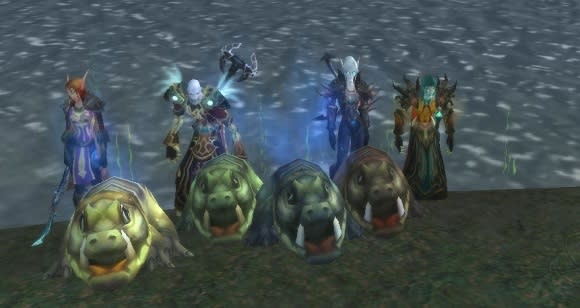
An unwelcome makeover
In the patch, Blizzard optimized player models to increase game performance. The change was undocumented, and in most cases it was impossible to tell. The effect was very noticeable on human females, however. In some cases they had quite a different expression. Players got so angry over the human female changes that Blizzard backed off from altering the models at all for five years. As we learned at BlizzCon 2013, they are finally updating the models in Warlords of Draenor.
Other notable changes
During TBC, we still played WoW in an era of spell ranks. Ranks of spells learned via talents, once upon a time, had to be repurchased each time you spec'ed into them. It was extremely annoying, especially when you realized you hadn't done it just as you got back to your team deep inside the instance. In this patch, Blizzard finally made the ranks a one-time purchase.
Prior to 2.4, Ritual of Summoning did not work inside instances. Players had to run all the way out of a dungeon or raid to summon allies. The patch made it possible to use the spell in instances, as long as the player met the requirements. Warlocks everywhere rejoiced.
Spirit was buffed in a strange way. They tied it to your intellect, so that higher intellect granted more mana regen from spirit.
Spell haste was also buffed. It now lowered the global cooldown as well as reducing cast time. This only applied to caster spells, not melee or hunter abilities.
Speaking of globals, this patch reduced the GCD for totems to 1 second.
Diminishing returns from honorable kills were eliminated. Instead, to combat battleground honor farming, a player stopped providing honor once they had died 50 times in a single BG.
The patch added daily quests for world PvP in Halaa and the Bone Wastes of Terokkar.
Weapon skills became faster to level from levels 1-59.
This patch allowed all tracking abilities to persist through death.
The terrifying Monstrous Kaliri became even more deadly. They were trained how to chase players in all directions.
Bandages, of all things, were nerfed.
The Weirdest Patch Notes Awards go to

A PvP-flagged player can no longer kiss Mojo and cause non-flagged players to become flagged.
Saber/Tiger Mounts will now make footprints when walking backwards in snow.
Ogri'la Peacekeeper's weapons have been scaled to a size more appropriate for keeping the peace.
Zapetta will no longer become confused about whether the zeppelin in Orgrimmar is arriving or leaving.
Legacy of the Sunwell
Patch 2.4 certainly brought The Burning Crusade to a close with a bang. Few patches have ever given players so much content.
The patch also taught Blizzard several lessons. The success of the Shattered Sun Offensive offered a new template for realm-wide events and encouraged Blizzard to do more of them. The difficulty of Magister's Terrace and Sunwell Plateau led to big changes in Wrath. After this patch, Blizzard designed endgame PvE content to be more accessible to the average player. They may have gone too far in Wrath, depending on whom you ask. Regardless, patch 2.4 was the last time a raid would be seen by less than 1% of the population -- and most would agree that WoW is better off.
Check out the full patch notes on the next page!

After months of surveying, WoW Archivist has been dug back up! Discover lore and artifacts of WoW's past, including the Corrupted Blood plague, the Scepter of the Shifting Sands, and the mysterious Emerald Dream.
